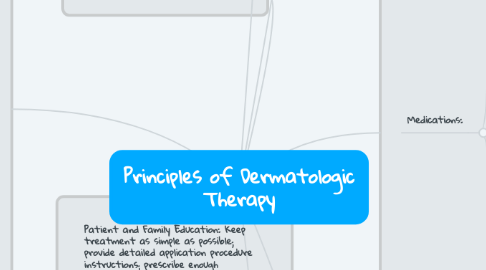
1. Buttaro, T.M., Trybulski, J., Polgar Bailey, P., & Sandberg-Cook, J. (2017). Primary Care: A collaborative practice (5th ed.). p 526-530. St. Louis, MO: Elsevier.
2. Definition and Epidemiology: Accurate diagnosis requires thorough history, ID of type of lesion to be treated, medication and vehicle of active medication and application method. The type of lesion guides therapy.
3. Skin Structure: Three main layers form the skin. Skin is the largest organ. Provides a barrier to passage of substances into the body.
3.1. Stratum corneum: most superficial section of the epidermis (outer layer) ; consists of enucleated keratinocytes which are filled with keratin and an interfilamentous matrix. Thickness and permeability varies on different parts of the body. Inflammation interrupts protective barrier and drug absorption is altered. Older adults have dryer, thinner, less elastic skin.
3.2. Dermis: vascularized; contains connective tissue and skin appendages (middle layer)
3.3. Hypodermis: composed of adipose tissue (subcutaneous layer)
4. Patient and Family Education: Keep treatment as simple as possible; provide detailed application procedure instructions; prescribe enough medication to complete therapy and discard leftover; Include whether to moisten skin prior to application, amount to apply, area of application, whether dressing should be applied over area treated, and instruct patients to not apply medication to unaffected areas. Counsel patient about adverse reactions and when to seek medical attention.
5. Topical Corticosteroids: treat a variety of dermatologic conditions. Cause reduction of inflammatory response, vasoconstriction, decreased collagen synthesis.
5.1. Potential adverse effects: altered collagen synthesis resulting in striae and tissue atrophy (may be reversible with discontinuation); Telangiectasia and purpura 2/thinning of epidermis
5.1.1. Higher potency and prolonged use increase potential for adverse effects; occlusive dressings increase drug penetration, increasing potential for adverse reactions
5.2. Topical Corticosteroids Ranked by Potency:
5.2.1. Group 1: most potent; clobetasol propionate (cream, ointment, lotion); Betamethasone dipropionate (ointment); Halobetasol propionate (cream, ointment)
5.2.2. Group 2: fluconazole (cream, ointment, gel, solution); mometasone furoate (ointment); betamethasone dipropionate (ointment); amcinonide (ointment); Desoximetasone (cream, ointment, gel)
5.2.3. Group 3: triamcinolone acetonide (ointment); amcinonide (cream, lotion); betamethasone dipropionate (cream); betamethasone valerate (ointment); fluticasone propionate (ointment)
5.2.4. Group 4: mometasone furoate (cream, lotion); triamcinolone acetonide (cream); fluocinolone acetonide (ointment); hydrocortisone valerate (ointment)
5.2.5. Group 5: fluticasone propionate (cream); fluticasone acetonide (cream); betamethasone valerate (cream); hydrocortisone valerate (cream); betamethasone dipropionate (lotion); prednicarbate (cream)
5.2.6. Group 6: fluocinolone acetonide (solution); betamethasone valerate (lotion); triamcinolone acetonide (cream); desonide (cream, ointment, lotion); alclometasone dipropionate (cream, ointment)
5.2.7. Group 7: (least potent); hydrocortisone (cream, ointment, lotion); pramoxine hydrochloride (cream)
5.3. Groups I & II: treat psoriasis, lichen planus, discoid lupus (use on face may be justified), severe hand eczema, severe poison ivy, lichen simplex chronicus, hyperkeratotic eczema, chapped feet, lichen sclerosus et atrophicus, alopecia areata, sever nummular eczema, atopic dermatitis (resistant adult cases)
5.4. Groups III-V: treat atopic dermatitis, nummular eczema, asteatotic eczema, stasis dermatitis, seborrheic dermatitis, lichen sclerosus et atrophicus (vulva), intertrigo (brief course), tinea (brief, to control inflammation), scabies (after scabicide), intertrigo (severe cases), anal inflammation (severe cases), severe dermatitis (face)
5.5. Groups VI-VII: dermatitis (eyelids), Dermatitis (diaper area), mild dermatitis (face), mild anal inflammation, mild intertrigo
6. Prescribing: size of area to be treated; frequency of application, duration of treatment; one gram can cover a 10x10 cm area for one application
7. Medications:
7.1. Variables: drug penetration based on thickness of stratum corneum. More permeable = face, scalp, axilla, scrotum & inflammation
7.1.1. Drug concentration affects absorption: increased concentration gradient = increased absorption
7.1.2. Passive diffusion is principle transport mechanism
7.1.3. Local half-life of topical medication is extended to allow once daily dosing
7.2. Dermatologic Vehicles: vehicle affects drugs ability to permeate skin. Vehicle can provide therapeutic benefits as well (ie: hydration). Occlusive dressings can enhance absorption up to 10x. Common vehicles: powders, oils, liquids, or combinations thereof.
7.2.1. Powders: absorb moisture, decrease friction, cover wide areas
7.2.1.1. promotes drying; increases surface area, decreases maceration and moisture; avoid in open wounds
7.2.2. Oils: provide emollient function, have occlusive properties which enhance drug absorption
7.2.3. Liquids: provide cooling, soothing by evaporation, help dry exudative lesions
7.2.4. Ointments: Water suspended in oil. excellent lubricant. Most potent vehicle due to occlusive effect. Best for dry, lichenified areas 2/lubrication & heat retention through decreased transepidermal water loss. Avoid in exudative infected lesions. Complications include: folliculitis, maceration, miliaria.
7.2.5. Creams: semisolid emulsion of oil in water. Less potent than ointment/stronger than lotion. Wash off with water. Helps retain moisture. Useful in high humidity environments.
7.2.6. Lotions: Powder-in- water. Less potent vehicle. Used in moist areas, dermatoses, pruritus, hairy areas, large areas. Provide cooling effect. Good for moist, pruritic skin. cools and dries as it evaporates.
7.2.7. Solutions: Water combined with medications or substances. Best for open or closed dressings, infected dermatoses, or hairy areas. Can be used as bath soaks to provide coolness and aid in drying of exudative lesions
7.2.7.1. Wet dressing: open - antiinflammatory & vasoconstrictive; decreases edema, removes crusts, relief of pruritus via evaporation and cooling
7.2.7.2. Wet dressing; closed - retains heat and causes maceration
7.2.7.3. Bath soaks: lukewarm,20-30 minute soak time; oils may cause tub to become slippery
7.2.8. Gel: oil-in-water, semisolid emulsion w/alcohol as base. transparent/colorless, liquifies on contact. Used on hairy areas. Combine therapeutic advantages of ointments and cosmetic advantages of creams. Avoid on acutely inflamed skin.
7.2.9. Emulsion: water-in-oil, less occlusive than ointment
7.2.10. Paste: Less greasy than ointment; some drying action; good protective barrier
7.2.11. Fixed: decreases edema; leave dressing in place x 1 week; removed by soaking in warm water
